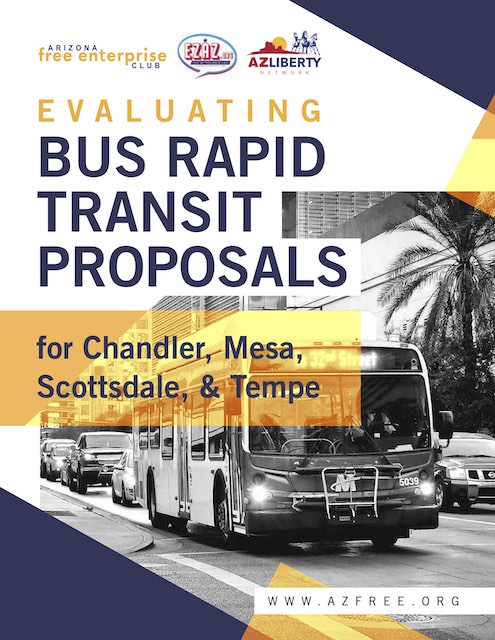Dedicating two of the six lanes on major streets in Chandler, Mesa, Scottsdale, and Tempe exclusively to buses would be a complete waste, says a new report released last week by the Arizona Free Enterprise Club and two other groups in the Phoenix area. Each of the lanes that Valley Metro would take for buses typically move roughly three to four times as many people per day as would have taken the bus before the pandemic, and bus ridership has fallen by 50 percent since the pandemic.
 Click image to download a 1.1-MB PDF of this 16-page report.
Click image to download a 1.1-MB PDF of this 16-page report.
The report notes that bus rapid transit typically stops about once per mile compared with five or six times per mile for local buses. This allows the BRT buses to go faster, which along with higher frequencies makes them more attractive to riders. Giving the buses their own lanes does not significantly increase their speeds, but it does increase congestion for everyone else.
The report also argues that giving the buses priority at traffic signals risks delaying hundreds of thousands of auto users whose paths would cross the BRT routes each day in order to improve travel for a few thousand bus riders per day. The speed advantage to bus riders would be hugely outweighed by the delays to auto drivers and passengers.
Part of the BRT plan is to subsidize transit-oriented developments along the route. “In essence, Valley Metro is admitting that it doesn’t know how to serve a low-density, 21st-century urban area like Phoenix,” says the report, “so instead it wants to reshape the region into an urban area that it can serve better.” But people don’t want to live in high-density developments, and those people who do live in them don’t necessarily use transit significantly more than everyone else.
Dedicated bus lanes are capable of moving tens of thousands of people per hour. Nowhere in Phoenix is demand for transit strong enough to warrant that level of traffic. Nor is it worth spending $100 million or more per street to make such conversions, especially in light of low transit ridership since the pandemic.
Instead of dedicated lanes, the report recommends the Valley Metro experiment with “lite BRT,” which means running frequent buses in shared lanes and coordinating traffic signals so everyone can minimize the number of stops they have to make. If these modest improvements significantly increase ridership, Valley Metro could experiment with other improvements, but if they don’t, “then it is unlikely that . . . dedicated lanes and traffic signal priority would do any better.”







